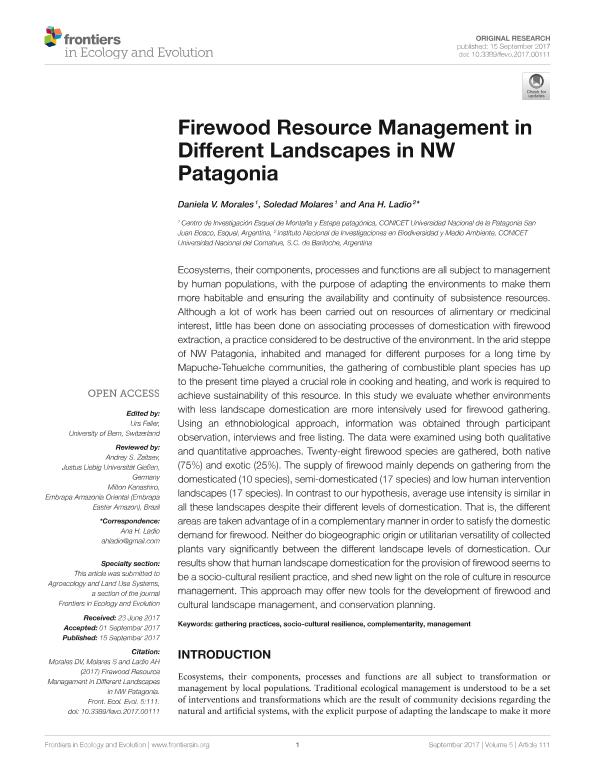Mostrar el registro sencillo del ítem
dc.contributor.author
Morales, Daniela Vanesa

dc.contributor.author
Molares, Soledad

dc.contributor.author
Ladio, Ana Haydee

dc.date.available
2018-01-10T19:18:51Z
dc.date.issued
2017-09
dc.identifier.citation
Molares, Soledad; Ladio, Ana Haydee; Morales, Daniela Vanesa; Firewood Resource Management in Different Landscapes in NW Patagonia; Frontiers; Frontiers in Ecology and Evolution; 5; 9-2017; 1-13; 111
dc.identifier.uri
http://hdl.handle.net/11336/32881
dc.description.abstract
Ecosystems, their components, processes and functions are all subject to management by human populations, with the purpose of adapting the environments to make them more habitable and ensuring the availability and continuity of subsistence resources. Although a lot of work has been carried out on resources of alimentary or medicinal interest, little has been done on associating processes of domestication with firewood extraction, a practice considered to be destructive of the environment. In the arid steppe of NW Patagonia, inhabited and managed for different purposes for a long time by Mapuche-Tehuelche communities, the gathering of combustible plant species has up to the present time played a crucial role in cooking and heating, and work is required to achieve sustainability of this resource. In this study we evaluate whether environments with less landscape domestication are more intensively used for firewood gathering. Using an ethnobiological approach, information was obtained through participant observation, interviews and free listing. The data were examined using both qualitative and quantitative approaches. Twenty-eight firewood species are gathered, both native (75%) and exotic (25%). The supply of firewood mainly depends on gathering from the domesticated (10 species), semi-domesticated (17 species) and low human intervention landscapes (17 species). In contrast to our hypothesis, average use intensity is similar in all these landscapes despite their different levels of domestication. That is, the different areas are taken advantage of in a complementary manner in order to satisfy the domestic demand for firewood. Neither do biogeographic origin or utilitarian versatility of collected plants vary significantly between the different landscape levels of domestication. Our results show that human landscape domestication for the provision of firewood seems to be a socio-cultural resilient practice, and shed new light on the role of culture in resource management. This approach may offer new tools for the development of firewood and cultural landscape management, and conservation planning.
dc.format
application/pdf
dc.language.iso
eng
dc.publisher
Frontiers

dc.rights
info:eu-repo/semantics/openAccess
dc.rights.uri
https://creativecommons.org/licenses/by-nc-sa/2.5/ar/
dc.subject
Gathering Practices
dc.subject
Complementarity
dc.subject
Socio-Cultural Resilience
dc.subject
Management
dc.subject.classification
Silvicultura

dc.subject.classification
Agricultura, Silvicultura y Pesca

dc.subject.classification
CIENCIAS AGRÍCOLAS

dc.title
Firewood Resource Management in Different Landscapes in NW Patagonia
dc.type
info:eu-repo/semantics/article
dc.type
info:ar-repo/semantics/artículo
dc.type
info:eu-repo/semantics/publishedVersion
dc.date.updated
2017-12-15T14:32:15Z
dc.identifier.eissn
2296-701X
dc.journal.volume
5
dc.journal.pagination
1-13; 111
dc.journal.pais
Suiza

dc.description.fil
Fil: Morales, Daniela Vanesa. Consejo Nacional de Investigaciones Científicas y Técnicas. Centro Científico Tecnológico Conicet - Patagonia Norte. Centro de Investigación Esquel de Montaña y Estepa Patagóica. Universidad Nacional de la Patagonia "San Juan Bosco". Facultad de Ciencias Naturales - Sede Esquel. Centro de Investigación Esquel de Montaña y Estepa Patagónica; Argentina
dc.description.fil
Fil: Molares, Soledad. Consejo Nacional de Investigaciones Científicas y Técnicas. Centro Científico Tecnológico Conicet - Patagonia Norte. Centro de Investigación Esquel de Montaña y Estepa Patagóica. Universidad Nacional de la Patagonia "San Juan Bosco". Facultad de Ciencias Naturales - Sede Esquel. Centro de Investigación Esquel de Montaña y Estepa Patagónica; Argentina
dc.description.fil
Fil: Ladio, Ana Haydee. Consejo Nacional de Investigaciones Científicas y Técnicas. Centro Científico Tecnológico Conicet - Patagonia Norte. Instituto de Investigaciones en Biodiversidad y Medioambiente. Universidad Nacional del Comahue. Centro Regional Universidad Bariloche. Instituto de Investigaciones en Biodiversidad y Medioambiente; Argentina
dc.journal.title
Frontiers in Ecology and Evolution
dc.relation.alternativeid
info:eu-repo/semantics/altIdentifier/doi/http://dx.doi.org/10.3389/fevo.2017.00111
dc.relation.alternativeid
info:eu-repo/semantics/altIdentifier/url/https://www.frontiersin.org/articles/10.3389/fevo.2017.00111/full
Archivos asociados
